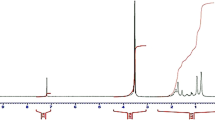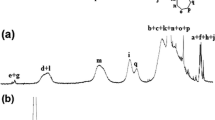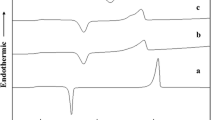Abstract
Poly(2-vinylpyridine)s (P2VPs) are important polymers with extensive applications in modern day material science. P2VP is an exceptional case for liquid chromatography because of certain polar interactions with most of the stationary phases. In the present study, we established the critical adsorption point (CAP) of P2VP for the first time. The effectiveness of the method is demonstrated by analyses of blends and block copolymers of P2VP and PMMA. The CAP of PMMA is established for determination of molar mass of P2VP component of above mentioned blends and block copolymers. The methods successfully demonstrate the separation of both types of homopolymers from the rest of the samples in conjunction with the determination of molar mass distribution of noncritical block or component.

ᅟ









Similar content being viewed by others
References
Higgins JS, Tambasco M, Lipson JEG (2005) Polymer blends; stretching what we can learn through the combination of experiment and theory. Prog Polym Sci 30(8/9):832–843
Yu L, Dean K, Li L (2006) Polymer blends and composites from renewable resources. Prog Polym Sci 31(6):576–602
Alexandridis P, Lindman B (eds) (2000) Amphiphilic block copolymers, self assembly and applications. Elsevier, Amsterdam
Hadjichristidis N, Pispas S, Floudas G (2003) Block copolymers: synthetic strategies, physical properties, and applications. Wiley, Hoboken
Hamley IW (2005) Block copolymers in solution: fundamentals and applications. Wiley, Chichester
Darling SB (2007) Directing the self-assembly of block copolymers. Prog Polym Sci 32(10):1152–1204
Thode CJ, Cook PL, Jiang Y, Onses MS, Ji S, Himpsel FJ, Nealey PF (2013) In situ metallization of patterned polymer brushes created by molecular transfer print and fill. Nanotechnology. doi:10.1088/0957-4484/24/15/155602
Kodiyath R, Choi I, Patterson B, Tsitsilianis C, Tsukruk VV (2013) Interfacial behavior of pH responsive ampholytic heteroarm star block terpolymers. Polymer 54(3):1150–1159
Hahn J, Filiz V, Rangou S, Lademann B, Buhr K, Clodt JI, Jung A, Abetz C, Abetz V (2013) PtBS-b-P4VP and PTMSS-b-P4VP isoporous integral-asymmetric membranes with high thermal and chemical stability. Macromol Mater Eng 298(12):1315–1321
Matsushita Y, Hayashida K, Takano A (2010) Jewelry box of morphologies with mesoscopic length scales – ABC star-shaped terpolymers. Macromol Rapid Commun 31(18):1579–1587
Li J, Khan IM (1993) Highly conductive solid polymer electrolytes prepared by blending high-molecular-weight poly(ethylene oxide), poly(2-vinylpyridine or 4- vinylpyridine), and lithium perchlorate. Macromolecules 26(17):4544–4550
Araneda E, Leiva A, Gargallo L, Hadjichristidis N, Mondragon I, Radic D (2011) Crystallization behavior of PEO in blends of poly(ethylene oxide)/poly(2-vinyl pyridine)-b-(ethylene oxide) block copolymer. Polym Eng Sci 52(5):1128–1136
Posel Z, Limpouchová Z, Šindelka K, Lísal M, Procházka K (2014) Dissipative particle dynamics study of the ph-dependent behavior of poly(2-vinylpyridine)-block- poly(ethylene oxide) diblock copolymer in aqueous buffers. Macromolecules 47(7):2503–2514
Jung A, Filiz V, Rangou S, Buhr K, Merten P, Hahn J, Clodt J, Abetz C, Abetz V (2013) Formation of integral asymmetric membranes of AB diblock and ABC triblock copolymers by phase inversion. Macromol Rapid Commun 34(7):610–615
Fan H, Jin Z (2014) Freezing polystyrene-b-poly(2-vinylpyridine) micelle nanoparticles with different nanostructures and sizes. Soft Matter 10(16):2848–2855
Fu X, Song L, Liu J, Li X, Zhang X, Jia Y (2012) One-step approach for the preparation of organic-inorganic janus-like particles by alkalization of polystyrene- block-poly(2-vinylpyridine)/FeCl3 complex micelles. Macromol Chem Phys 213(16):1663–1668
McGrath N, Patil AJ, Watson SMD, Horrocks BR, Faul CFJ, Houlton A, Winnik MA, Mann S, Manners I (2013) Conductive, monodisperse polyaniline nanofibers of controlled length using well-defined cylindrical block copolymer micelles as templates. Chem-Euro J 19(39):13030–13039
Tress M, Mapesa EU, Kossack W, Kipnusu WK, Reiche M, Kremer F (2013) Glassy dynamics in condensed isolated polymer chains. Science 341(6152):1371–1374
Tsitsilianis C, Stavrouli N, Bocharova V, Angelopoulos S, Kiriy A, Katsampas I, Stamm M (2008) Stimuli responsive associative polyampholytes based on ABCBA pentablock terpolymer architecture. Polymer 49(13/14):2996–3006
Rudolph T, Barthel MJ, Kretschmer F, Mansfeld U, Hoeppener S, Hager MD, Schubert US, Schacher FH (2014) Poly(2-vinyl pyridine)-block-poly(ethylene oxide) featuring a furan group at the block junction—synthesis and functionalization. Macromol Rapid Commun 35(9):916–921
Butsele KV, Stoffelbach F, Jérôme R, Jérôme C (2006) Synthesis of novel amphiphilic and pH-sensitive ABC Miktoarm star terpolymers. Macromolecules 39(17):5652–5656
Matsuo Y, Oie T, Goseki R, Ishizone T, Sugiyama K, Hirao A (2013) Precise synthesis of new triblock co- and terpolymers by a methodology combining living anionic polymers with a specially designed linking reaction. Macromol Symp 323(1):26–36
Fragouli PG, Iatrou H, Hadjichristidis N, Sakurai T, Hirao A (2006) Synthesis and characterization of model 3-miktoarm star copolymers of poly(dimethylsiloxane) and poly(2-vinylpyridine). J Polym Sci A Polym Chem 44(1):614–619
Su M, Huang H, Ma X, Wang Q, Su Z (2013) Poly(2-vinylpyridine)-block -poly(ϵ- caprolactone) single crystals in micellar solution. Macromol Rapid Commun 34(13):1067–1071
Dockendorff J, Gauthier M (2014) Synthesis of arborescent polystyrene-g-[poly(2- vinylpyridine)-b-polystyrene] core–shell–corona copolymers. J Polym Sci A Polym Chem 52(8):1075–1085
Park S, Chang T (2006) Characterization of poly(2-vinylpyridine) by temperature gradient interaction chromatography. Macromolecules 39(9):3466–3468
Cho D, Noro A, Takano A, Matsushita Y (2005) TGIC separation of PS-b-P2VP diblock and P2VP-b-PS-b-P2VP triblock copolymers according to chemical composition. Macromolecules 38(7):3033–3036
Baumgaertel A, Altuntaş E, Schubert US (2012) Recent developments in the detailed characterization of polymers by multidimensional chromatography. J Chromatogr A 1240:1–20
Macko T, Hunkeler D (2003) Liquid chromatography under critical and limiting conditions: a survey of experimental systems for synthetic polymers. Adv Polym Sci 163:6–136
Malik MI, Pasch H (2014) Novel developments in the multidimensional characterization of segmented copolymers. Prog Polym Sci 39(1):87–123
Radke W, Rode K, Gorshkov AV, Biela T (2005) Chromatographic behavior of fuctionalized star-shaped poly(lactide)s under critical conditions of adsorption. Comparison of theory and experiment. Polymer 46(15):5456–5465
Sinha P, Hiller W, Pasch H (2014) HPLC-1H-NMR characterization of polystyrene- block-polyisoprene copolymers: LCCC-1H-NMR using a single mobile phase. Macromol Symp 337(1):44–50
Mekap D, Macko T, Brüll R, Cong R, deGroot AW, Parrott A, Cools PJCH, Yau W (2013) Liquid chromatography at critical conditions of polyethylene. Polymer 54(21):5518–5524
Smigovec Ljubic T, Pahovnik D, Zigon M, Zagar E (2012) Separation of poly(styrene- block-t-butyl methacrylate) copolymers by various liquid chromatography techniques. Sci World J. doi:10.1100/2012/932609
Sinha P, Hiller W, Bellas V, Pasch H (2012) Analysis of polystyrene-b-polyisoprene copolymers by coupling of liquid chromatography at critical conditions to NMR at critical conditions of polystyrene and polyisoprene. J Sep Sci 35(14):1731–1740
Sinha P, Hiller W, Pasch H (2010) Characterisation of blends of polyisoprene and polystyrene by on-line hyphenation of HPLC and 1H-NMR: LC-CC-NMR at critical conditions of both homopolymers. J Sep Sci 33(22):3494–3500
Malik MI, Trathnigg B, Kappe CO (2009) Amphiphilic polymers based on higher alkylene oxides. Synthesis and characterization by different chromatographic techniques. J Chromatogr A 1216(7):1167–1173
Malik MI, Sinha P, Bayley GM, Mallon PE, Pasch H (2011) Characterization of polydimethylsiloxane-block-polystyrene (PDMS-b-PS) Copolymers by liquid chromatography at critical conditions. Macromol Chem Phys 212(12):1221–1228
Malik MI, Harding G, Pasch H (2012) Two-dimensional liquid chromatography of PDMS–PS block copolymers. Anal Bioanal Chem 403(2):601–611
Malik MI, Harding GW, Grabowsky ME, Pasch H (2012) Two-dimensional liquid chomatography of polystyrene–polyethylene oxide block copolymers. J Chromatogr A 1244:77–87
Baran K, Laugier S, Cramail H (2001) Fractionation of functional polystyrenes, poly(ethylene oxide)s and poly(styrene)-b-poly(ethylene oxide) by liquid chromatography at the exclusion–adsorption transition point. J Chromatogr B 753(1):139–149
Hulst MV, Horst AVD, Kok WT, Schoenmakers PJ (2010) Comprehensive 2-D chromatography of random and block methacrylate copolymers. J Sep Sci 33(10):1414–1420
Macko T, Hunkeler D, Berek D (2002) Liquid chromatography of synthetic polymers under critical conditions. The case of single eluents and the role of ϑ conditions. Macromolecules 35(5):1797–1804
Berek D, Tarbajovska J (2002) Evaluation of high-performance liquid chromatography column retentivity using macromolecular probes*1: II. Silanophilic interactivity traced by highly polar polymers. J Chromatogr A 976(1/2):27–37
Scholten AB, Claessens HA, de Haan JW, Cramers CA (1997) Chromatographic activity of residual silanols of alkylsilane derivatized silica surfaces. J Chromatogr A 759(1/2):37–46
Acknowledgments
Higher Education Commission (HEC) of Pakistan is acknowledged for the startup research grant number PM-IPFP/HRD/HEC/2012/2717.
Author information
Authors and Affiliations
Corresponding author
Rights and permissions
About this article
Cite this article
Malik, M.I., Mahboob, T. & Ahmed, S. Characterization of poly(2-vinylpyridine)-block-poly(methyl methacrylate) copolymers and blends of their homopolymers by liquid chromatography at critical conditions. Anal Bioanal Chem 406, 6311–6317 (2014). https://doi.org/10.1007/s00216-014-8075-2
Received:
Revised:
Accepted:
Published:
Issue Date:
DOI: https://doi.org/10.1007/s00216-014-8075-2




